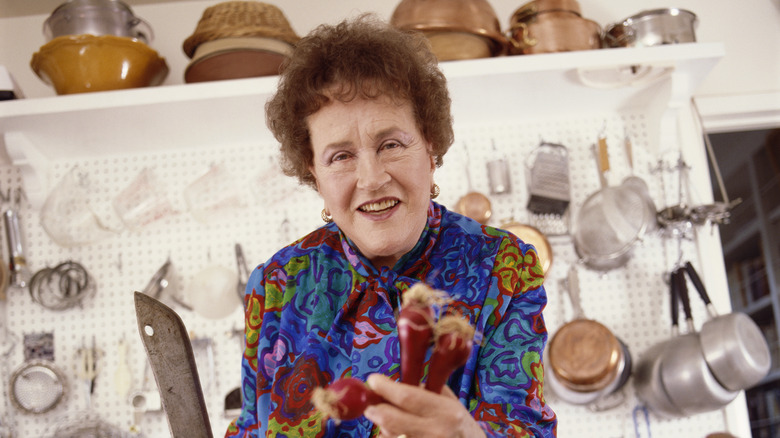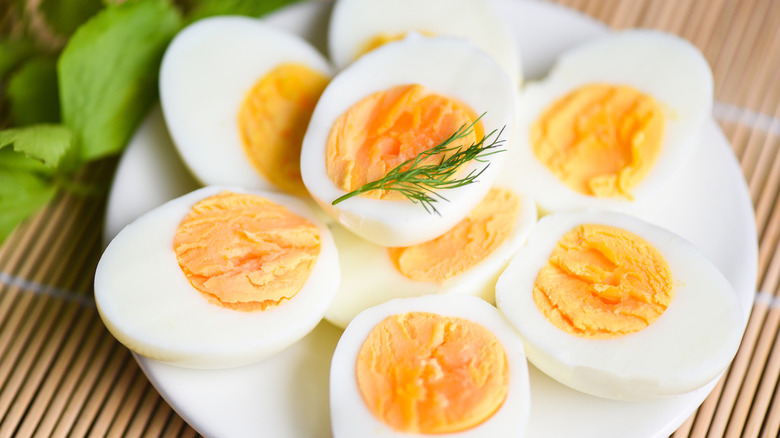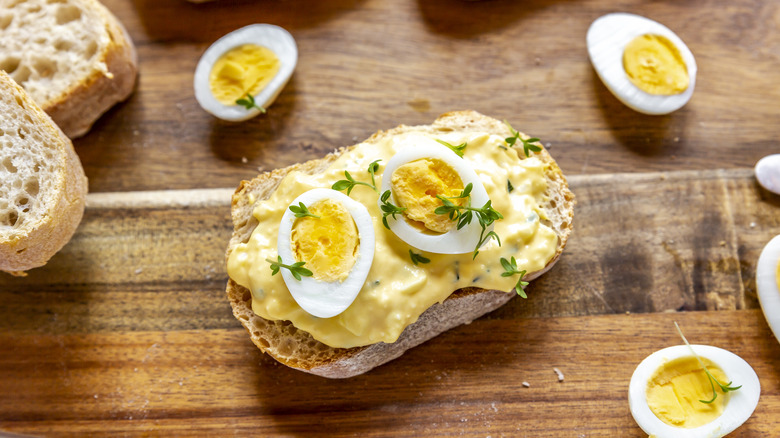Julia Child's Tip For Making The Best Hard-Boiled Eggs
Beloved television chef Julia Child was known for her many kitchen hacks. Be it tips on how to cook asparagus or the best technique for soaking beans, it seems like Child knew the smartest way to do just about everything. So when you hear that she had a very specific method for hard-boiling eggs, you know that it's the formula to be followed.
Julia's method, as explained on the Homemade Podcast by celebrity chef Sara Moulton, who once worked with Child, involves starting the eggs in room-temperature water, rather than tossing them into already boiling water (via EatingWell).
Place your eggs in water and bring the water to a boil over high heat. The moment the water begins to truly boil — aka when the water is bubbling and roiling — take the whole thing off of the heat completely. Leave your eggs in the water to simmer for around 14 minutes. Lastly, place the eggs into an ice water bath until they cool.
Why hard boil your eggs with this multi-step process? Moulton says that boiling eggs like Child means that "the whites are much more tender" and "you don't get that green line between the yolk and the white." These barely-boiled hard-boiled eggs give you a tender yolk that creates a fluffy, more flavorful basic egg salad, and light, bouncy whites that give you delicate, not chewy, classic deviled eggs.
The advantages of Julia Child's hard-boiling hack
Julia Child's hard-boiling method easily mitigates many of the issues that can arise when hard-boiling eggs, and essentially guarantees that instead of rubbery egg whites or gray, chalky yolks, you have light, boiled eggs that are ready to be devoured.
The green or gray line that can appear on the edge of the egg yolks is usually a result of overcooking the eggs. According to the American Egg Board, the unappealing ring is the of a chemical reaction between the sulfur in the egg white and iron in the egg yolk when left in too high heat for too long. The ring is harmless, but it is certainly not what you're looking to add to your dishes. Child's method doesn't leave the eggs in high heat, and transfers them to ice water, so there's no risk of overcooking.
Another advantage is that by shocking the hard-boiled eggs in ice water, they become several times easier to peel. There's no risk of burning your fingers on a scalding shell, and the shell and membrane of the eggs stick together better, meaning the peels almost slide right off. The cold-water soak is simply one of several ways to avoid mistakes when peeling hard-boiled eggs, and if it's recommended by Child, we're definitely ready to give it a shot.
How to use these hard-boiled eggs
Hard-boiled eggs are a great simple snack to have on hand, and can be stored in your fridge for about a week. They're excellent with just a little salt and pepper — or cut up on top of your morning bagel or avocado toast.
Of course, it's hard to think of hard-boiled eggs without thinking of a hearty egg salad sandwich. Dice your eggs, fold in some mayonnaise and mustard, and add some crushed potato chips or pickles for an elevated egg salad with crunch. If you're into a super thick recipe, you can add in some cream cheese for a Polish egg salad.
Hard-boiled eggs are also a protein-rich addition to a classic summer potato salad. They pair excellently with parsley, onion, and even some capers if you have them on hand. For a more classy vibe, try an asparagus salad – chop up your hard-boiled eggs, layer them over blanched asparagus, and drizzle a Dijon mustard and vinegar sauce on top.
For an eggy dinner dish, you can use your eggs in a hard-boiled egg gratin. Create a creamy béchamel sauce with butter, milk, and a bit of flour. Layer the sauce, slices of your hard-boiled eggs, more sauce, and sprinkle a bit of grated Gruyère cheese on top. Place in the oven until the top is golden brown and enjoy! You can also layer in some spinach if you're looking for a heartier dish.



